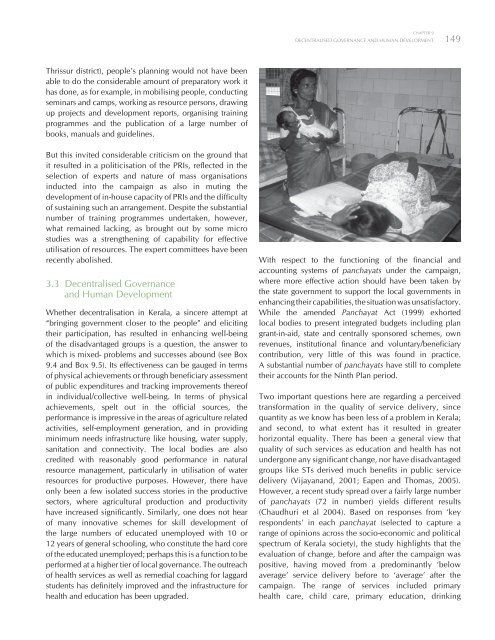Kerala 2005 - of Planning Commission
Kerala 2005 - of Planning Commission
Kerala 2005 - of Planning Commission
You also want an ePaper? Increase the reach of your titles
YUMPU automatically turns print PDFs into web optimized ePapers that Google loves.
CHAPTER 9<br />
DECENTRALISED GOVERNANCE AND HUMAN DEVELOPMENT<br />
149<br />
Thrissur district), people’s planning would not have been<br />
able to do the considerable amount <strong>of</strong> preparatory work it<br />
has done, as for example, in mobilising people, conducting<br />
seminars and camps, working as resource persons, drawing<br />
up projects and development reports, organising training<br />
programmes and the publication <strong>of</strong> a large number <strong>of</strong><br />
books, manuals and guidelines.<br />
But this invited considerable criticism on the ground that<br />
it resulted in a politicisation <strong>of</strong> the PRIs, reflected in the<br />
selection <strong>of</strong> experts and nature <strong>of</strong> mass organisations<br />
inducted into the campaign as also in muting the<br />
development <strong>of</strong> in-house capacity <strong>of</strong> PRIs and the difficulty<br />
<strong>of</strong> sustaining such an arrangement. Despite the substantial<br />
number <strong>of</strong> training programmes undertaken, however,<br />
what remained lacking, as brought out by some micro<br />
studies was a strengthening <strong>of</strong> capability for effective<br />
utilisation <strong>of</strong> resources. The expert committees have been<br />
recently abolished.<br />
3.3 Decentralised Governance<br />
and Human Development<br />
Whether decentralisation in <strong>Kerala</strong>, a sincere attempt at<br />
“bringing government closer to the people” and eliciting<br />
their participation, has resulted in enhancing well-being<br />
<strong>of</strong> the disadvantaged groups is a question, the answer to<br />
which is mixed- problems and successes abound (see Box<br />
9.4 and Box 9.5). Its effectiveness can be gauged in terms<br />
<strong>of</strong> physical achievements or through beneficiary assessment<br />
<strong>of</strong> public expenditures and tracking improvements there<strong>of</strong><br />
in individual/collective well-being. In terms <strong>of</strong> physical<br />
achievements, spelt out in the <strong>of</strong>ficial sources, the<br />
performance is impressive in the areas <strong>of</strong> agriculture related<br />
activities, self-employment generation, and in providing<br />
minimum needs infrastructure like housing, water supply,<br />
sanitation and connectivity. The local bodies are also<br />
credited with reasonably good performance in natural<br />
resource management, particularly in utilisation <strong>of</strong> water<br />
resources for productive purposes. However, there have<br />
only been a few isolated success stories in the productive<br />
sectors, where agricultural production and productivity<br />
have increased significantly. Similarly, one does not hear<br />
<strong>of</strong> many innovative schemes for skill development <strong>of</strong><br />
the large numbers <strong>of</strong> educated unemployed with 10 or<br />
12 years <strong>of</strong> general schooling, who constitute the hard core<br />
<strong>of</strong> the educated unemployed; perhaps this is a function to be<br />
performed at a higher tier <strong>of</strong> local governance. The outreach<br />
<strong>of</strong> health services as well as remedial coaching for laggard<br />
students has definitely improved and the infrastructure for<br />
health and education has been upgraded.<br />
With respect to the functioning <strong>of</strong> the financial and<br />
accounting systems <strong>of</strong> panchayats under the campaign,<br />
where more effective action should have been taken by<br />
the state government to support the local governments in<br />
enhancing their capabilities, the situation was unsatisfactory.<br />
While the amended Panchayat Act (1999) exhorted<br />
local bodies to present integrated budgets including plan<br />
grant-in-aid, state and centrally sponsored schemes, own<br />
revenues, institutional finance and voluntary/beneficiary<br />
contribution, very little <strong>of</strong> this was found in practice.<br />
A substantial number <strong>of</strong> panchayats have still to complete<br />
their accounts for the Ninth Plan period.<br />
Two important questions here are regarding a perceived<br />
transformation in the quality <strong>of</strong> service delivery, since<br />
quantity as we know has been less <strong>of</strong> a problem in <strong>Kerala</strong>;<br />
and second, to what extent has it resulted in greater<br />
horizontal equality. There has been a general view that<br />
quality <strong>of</strong> such services as education and health has not<br />
undergone any significant change, nor have disadvantaged<br />
groups like STs derived much benefits in public service<br />
delivery (Vijayanand, 2001; Eapen and Thomas, <strong>2005</strong>).<br />
However, a recent study spread over a fairly large number<br />
<strong>of</strong> panchayats (72 in number) yields different results<br />
(Chaudhuri et al 2004). Based on responses from ‘key<br />
respondents’ in each panchayat (selected to capture a<br />
range <strong>of</strong> opinions across the socio-economic and political<br />
spectrum <strong>of</strong> <strong>Kerala</strong> society), the study highlights that the<br />
evaluation <strong>of</strong> change, before and after the campaign was<br />
positive, having moved from a predominantly ‘below<br />
average’ service delivery before to ‘average’ after the<br />
campaign. The range <strong>of</strong> services included primary<br />
health care, child care, primary education, drinking

















